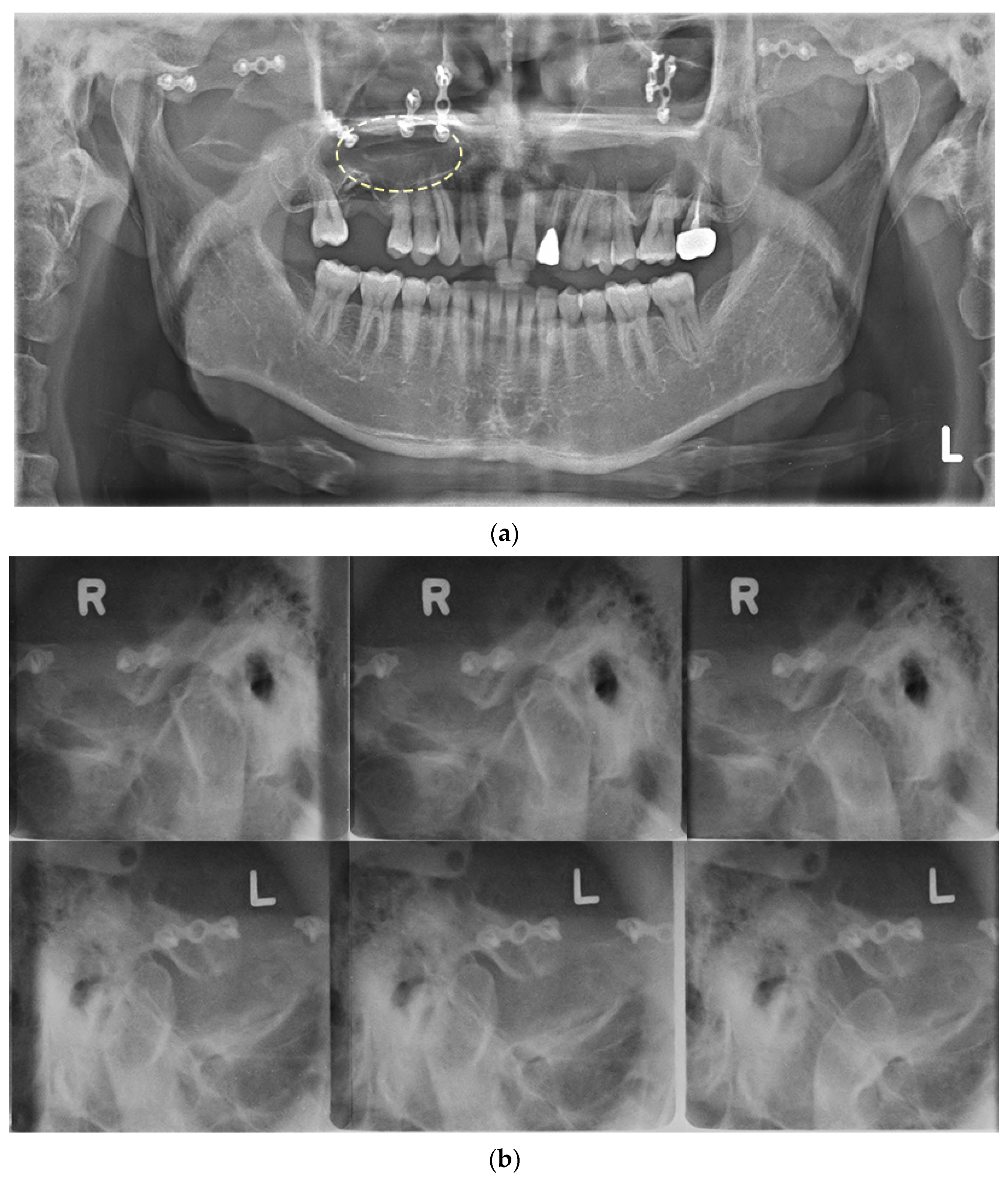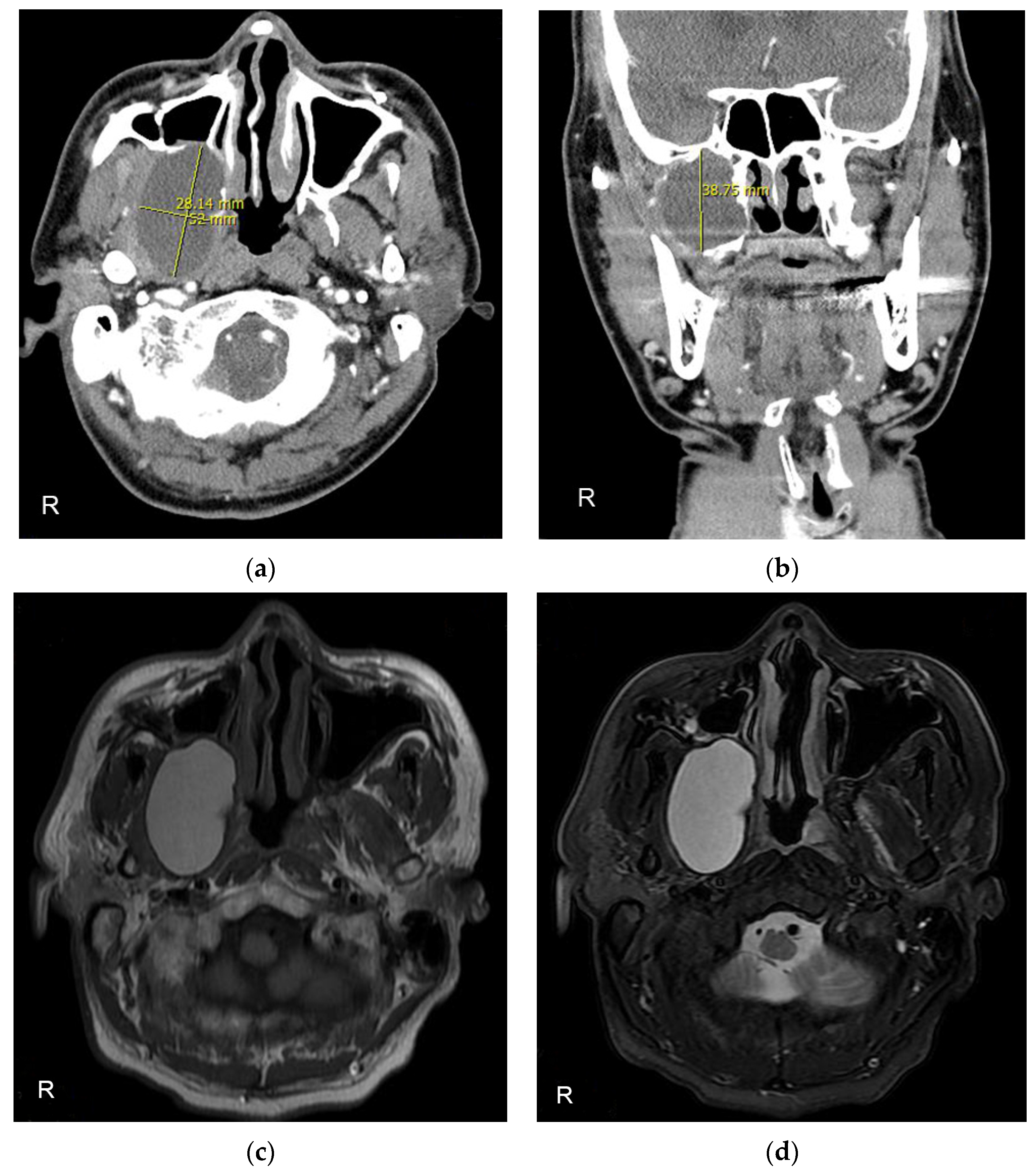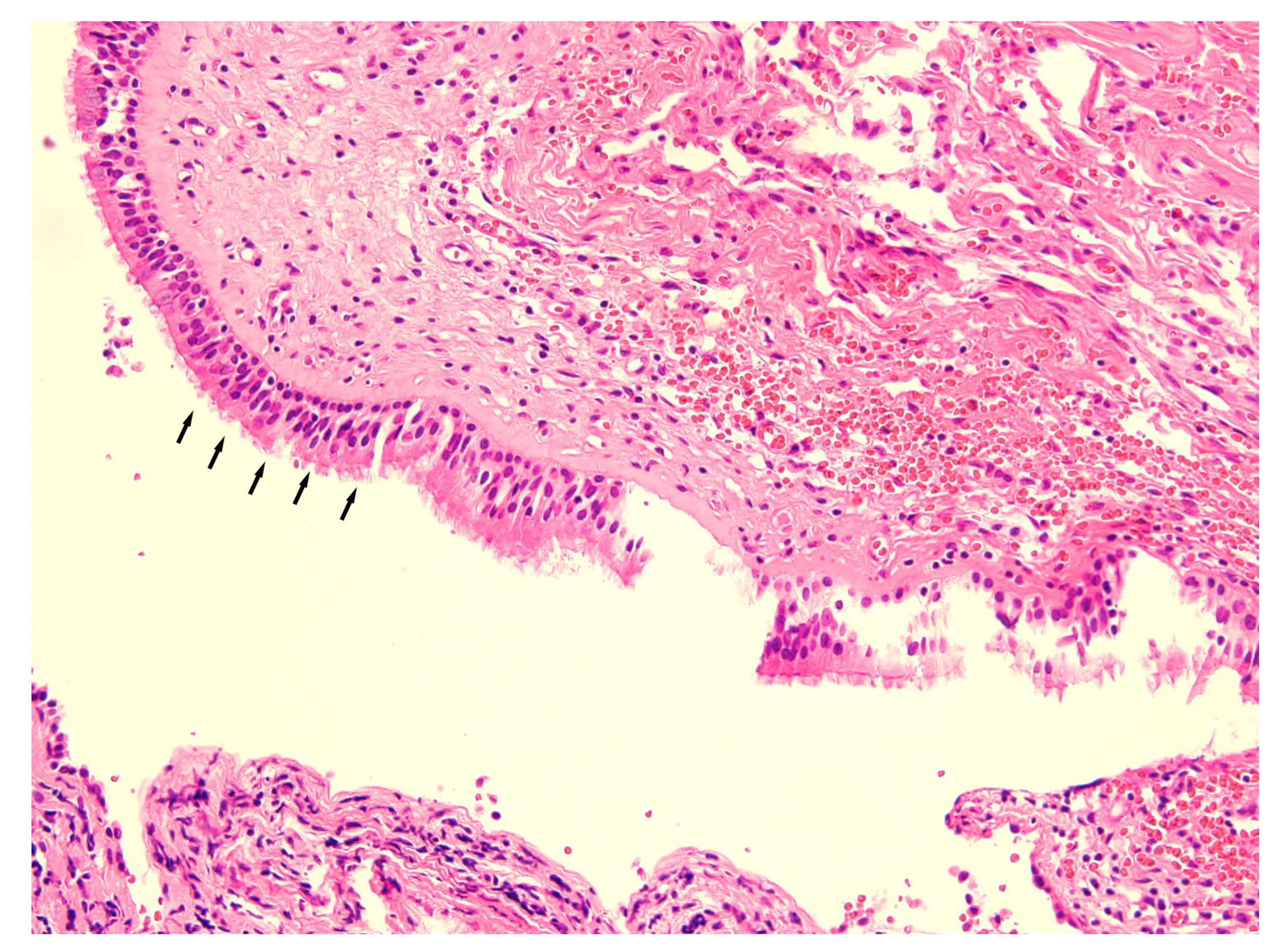Transoral Marsupialization of an Isolated Surgical Ciliated Cyst of the Infratemporal Fossa
Abstract
Author Contributions
Funding
Institutional Review Board Statement
Informed Consent Statement
Data Availability Statement
Conflicts of Interest
References
- Mete, O.; Wenig, B.M. Update from the 5th Edition of the World Health Organization Classification of Head and Neck Tumors: Overview of the 2022 WHO Classification of Head and Neck Neuroendocrine Neoplasms. Head Neck Pathol. 2022, 16, 123–142. [Google Scholar] [CrossRef] [PubMed]
- Bourgeois, S.L., Jr.; Nelson, B.L. Surgical ciliated cyst of the mandible secondary to simultaneous Le Fort I osteotomy and genioplasty: Report of case and review of the literature. Oral Surg. Oral Med. Oral Pathol. Oral Radiol. Endod. 2005, 100, 36–39. [Google Scholar] [CrossRef] [PubMed]
- Amin, M.; Witherow, H.; Lee, R.; Blenkinsopp, P. JJoo, surgery m: Surgical ciliated cyst after maxillary orthognathic surgery: Report of a case. J. Oral Maxillofac. Surg. 2003, 61, 138–141. [Google Scholar] [CrossRef] [PubMed]
- Joo, W.; Funaki, T.; Yoshioka, F.; Rhoton, A.L., Jr. Microsurgical anatomy of the infratemporal fossa. Clin. Anat. 2013, 26, 455–469. [Google Scholar] [CrossRef] [PubMed]
- Tiwari, R. JJoC-MS: Surgical landmarks of the infratemporal fossa. J. Craniomaxillofac. Surg. 1998, 26, 84–86. [Google Scholar]
- Chung, H.J.; Moon, I.S.; Cho, H.-J.; Kim, C.-H.; Sharhan, S.S.A.; Chang, J.H.; Yoon, J.-H. Analysis of Surgical Approaches to Skull Base Tumors Involving the Pterygopalatine and Infratemporal Fossa. J. Craniofac. Surg. 2019, 30, 589–595. [Google Scholar] [CrossRef] [PubMed]
- Haidar, H.; Deveze, A.; Lavieille, J.P. Mini-invasive surgery of infratemporal fossa schwannomas. J. Laryngol. Otol. 2015, 129, 187–193. [Google Scholar] [CrossRef] [PubMed]
- Hopkins, R.; Seel, D. The use of a Le Fort I osteotomy as a surgical approach. Br. J. Oral Surg. 1975, 13, 27–32. [Google Scholar] [CrossRef] [PubMed]
- Brown, D.H. The Le Fort I maxillary osteotomy approach to surgery of the skull base. J. Otolaryngol. 1989, 18, 289–292. [Google Scholar] [PubMed]
- Kramer, F.-J.; Baethge, C.; Swennen, G.; Teltzrow, T.; Schulze, A.; Berten, J. Brachvogel PJJoCS: Intra-and perioperative complications of the LeFort I osteotomy: A prospective evaluation of 1000 patients. J. Craniofac. Surg. 2004, 15, 971–977. [Google Scholar] [CrossRef] [PubMed]
- Basu, M.K.; Rout, P.G.J.; Rippin, J.W.; Smith, A.J. The post-operative maxillary cyst: Experience with 23 cases. Int. J. Oral Maxillofac. Surg. 1988, 17, 282–284. [Google Scholar] [CrossRef] [PubMed]
- Iinuma, T.; Mizutani, A.; Miyakawa, K.J.P.O. Postoperative cysts of the maxilla: A review of 474 cases. Pract. Otol 1974, 67, 427–436. [Google Scholar] [CrossRef]
- Gregory, G.J. Surgical ciliated cysts of the maxilla: Report of cases. J. Oral. Surg. 1958, 16, 251–253. [Google Scholar]
- Yoshikawa, Y.; Nakajima, T.; Kaneshiro, S.; Sakaguchi, M. Effective treatment of the postoperative maxillary cyst by marsupialization. J. Oral Maxillofac. Surg. 1982, 40, 487–491. [Google Scholar] [CrossRef] [PubMed]




Disclaimer/Publisher’s Note: The statements, opinions and data contained in all publications are solely those of the individual author(s) and contributor(s) and not of MDPI and/or the editor(s). MDPI and/or the editor(s) disclaim responsibility for any injury to people or property resulting from any ideas, methods, instructions or products referred to in the content. |
© 2023 by the authors. Licensee MDPI, Basel, Switzerland. This article is an open access article distributed under the terms and conditions of the Creative Commons Attribution (CC BY) license (https://creativecommons.org/licenses/by/4.0/).
Share and Cite
Kwack, D.-W.; Yoon, J.; Park, H.-S.; Lee, J.-H.; Kim, M.-Y. Transoral Marsupialization of an Isolated Surgical Ciliated Cyst of the Infratemporal Fossa. Diagnostics 2023, 13, 1825. https://doi.org/10.3390/diagnostics13111825
Kwack D-W, Yoon J, Park H-S, Lee J-H, Kim M-Y. Transoral Marsupialization of an Isolated Surgical Ciliated Cyst of the Infratemporal Fossa. Diagnostics. 2023; 13(11):1825. https://doi.org/10.3390/diagnostics13111825
Chicago/Turabian StyleKwack, Da-Woon, Jooha Yoon, Hae-Seo Park, Jung-Hwan Lee, and Moon-Young Kim. 2023. "Transoral Marsupialization of an Isolated Surgical Ciliated Cyst of the Infratemporal Fossa" Diagnostics 13, no. 11: 1825. https://doi.org/10.3390/diagnostics13111825
APA StyleKwack, D.-W., Yoon, J., Park, H.-S., Lee, J.-H., & Kim, M.-Y. (2023). Transoral Marsupialization of an Isolated Surgical Ciliated Cyst of the Infratemporal Fossa. Diagnostics, 13(11), 1825. https://doi.org/10.3390/diagnostics13111825





